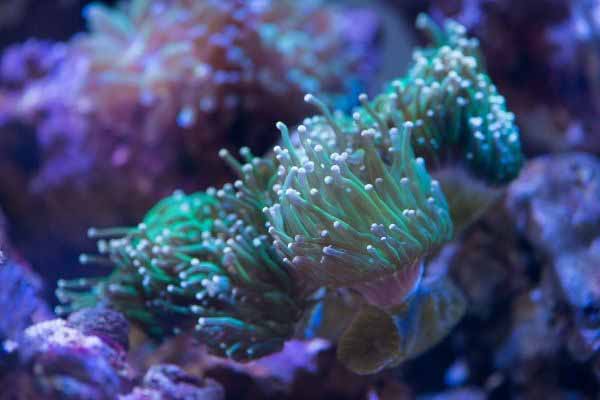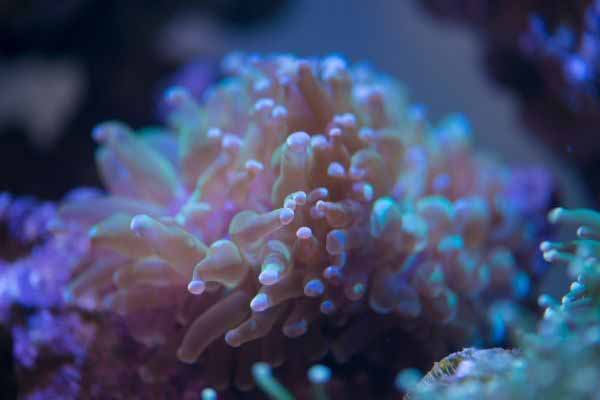[ad_1]
The Torch coral, Euphyllia glabrescens, is a large polyp stony coral that originates from the Indo-pacific reef regions. This LPS coral species (the torch coral), has long, flowing fleshy polyps that extend from a calcified (stony) base. In a moderate water flow, these corals look a bit like a torch, which is where they get their common name. This article will share some of the most important information to care for these awesome animals in a saltwater reef aquarium.
Table of contents:
Introduction to torch coral care
E. glabrescens are reported to live in a range of water conditions, from turbid (murky) waters to clear waters with blazingly crips light, suggesting a certain level of adaptability and beginner-friendliness which is likely one reason these corals are great beginner corals.

This torch coral was in my home aquarium
In the home aquarium, the Torch coral does not have particularly challenging husbandry requirements to be successfully cared for in a reef aquarium.
Like most large polyp stony corals, a torch coral benefits from moderate water flow. The polyps will remain retracted and under-inflated if the water current is too fast because the large flowing polyps are prone to rip and tear in high or ultra-high current environments.
Quick facts
- Common names: Torch, PomPom, or Trumpet, which is why common names are sometimes challenging in this hobby, because other corals have similar names
- Scientific names: Euphyllia glabrescens, which means they are in the same genus as Hammer, Frogspawn, & Bubble corals
- Care level: Requires moderately challenging care
- Light level: Does best with a moderate intensity of light
- Flow level: Prefers a moderate water flow
- Aggression: Aggressive–will sting neighboring corals, with one big, fun exception: they will tolerate other Euphyllia corals
Feeding the Torch coral
The torch coral is a photosynthetic coral, meaning it has a relationship with symbiotic zooxanthellae (single-cell photosynthetic organsims) that live inside its tissues that converts the light energy into sugar. In exhange for a home inside the coral, the zooxanthellae split their ‘harvest’ and feed the coral. Therefore, it is possible to keep the Torch coral without any feeding at all. However, all corals are animals, and animals are meant to eat. So while it is technically not necessary to feed them, the fact that they are biologically able to consume rather large, meaty meals, by coral standards, suggests to me that feeding of appropriately sized fare should be strongly encouraged.
Want to know the right way to feed your corals, check out this video:
Placement in the reef tank
The best placement for a torch coral is in a location that gets moderate water flow and moderate-intensity lighting. Just like Goldilocks, you don’t want the lights or the water flow to be too hot or too cool, you want them just right. What does that mean exactly?
Moderate flow
Well, the fringes/corners of your tank (unless right next to a powerhead or light source) are likely the lower flow, lower light areas of your tank. The areas directly in front of the flow of your powerheads or gyre pumps are likely areas of highest flow.
Moderate flow is achieved in the locations where the polyps are fully extended and gently swaying like they are in a breeze. Not still or bending like they’re in a storm, but swaying in a breeze.
Moderate light intensity
The best placement for your torches would generally be the middle-to-lower ends of the tank, still in reasonably bright light but not straight under the most intense section of the light.
Place them where both of those conditions exist
The best places in your aquarium, therefore, are where the lighting and water flow are both moderate. This may be anecdotal, but I have observed these corals to be ‘happier’ when placed in the sand, versus being glued at a mid-level on the live rock aquascape. Take that observation with a grain of reef salt.
Compatibility
Torch corals are compatible with just about any reef safe saltwater fish that won’t consider it food.
When keeping them with other corals, it is best to give them a wide birth. Torches are aggressive corals that protect themselves by wielding their sweeper tentacles maliciously. Sweeper tentacles are specialized tentacles that extend much larger than the typical tentacles and are equipped with stinging cells. Torches will send out these long tendrils to zap anything nearby within reach.
As mentioned earlier, Torch corals are part of the Euphyllia genus, and while they may try to sting and kill other neighboring corals that grow a little too close for comfort, they will grow very well next to Hammer and Frogspawn corals.
A note about leather corals
As a general rule, caution should be used when mixing leather corals and LPS species, like torches. Many leather coral species produce and release toxic chemicals, called terpenes, into the water to protect themselves and to stunt the growth of other species. Note a few sections have died back on this torch coral specimen shown below. This is likely due to a combination of starvation/insufficient light, and possibly chemical warfare between other coral species in the tank
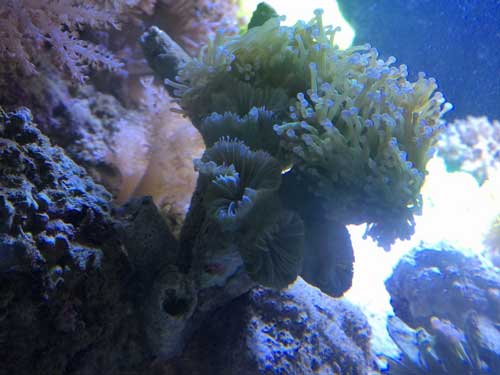
Note a few sections have died back on this torch coral specimen
Aggression and sweeper tentacles
Reproduction: propagation and how to frag
Since Euphyllia glabrescens is a branching stony coral species, it is fairly easy to propagate via fragging. You can cut, saw, or snap off a branch and it will grow into an entirely new colony all on its own.
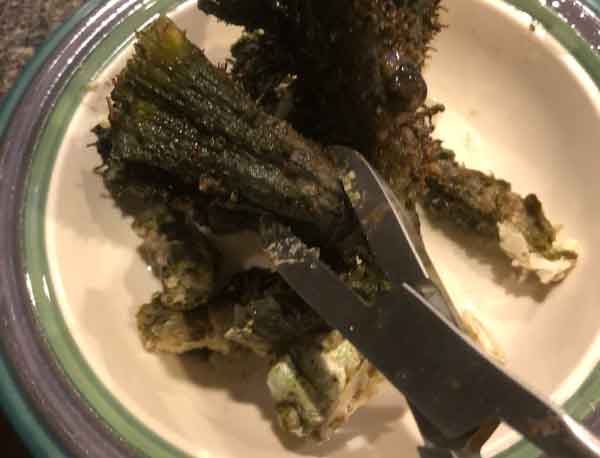
Just like pruning a bush, you want to cut a branching LPS coral close to the base. The metal instrument here is called ‘bone shears’ they make quick work of snapping the bony skeleton
The idea of breaking off pieces of your prized coral has scared off more than a few reefers, but hopefully, this article will give you a little confidence here. The fact that corals, like this one, can reproduce entirely new genetically identical colonies is a marvel of nature. The parent colonies generally respond to it really well. You can prune your colonies to keep them looking in tip-top shape and trade frags to your local fish store or with hobbyists in the area to expand your collection or make a little side cash.
A great reference to have, if you want to learn about fragging corals, is the book, How to Frag Corals, available on Amazon.com and iTunes.
Anticipating problems with keeping the torch coral
One of the biggest problems I have seen beginner hobbyists have is failing to account for the calcium demand for these corals. If there is insufficient calcium in your aquarium water, these corals will not be able to make their coral skeleton. You should also never lift a torch coral out of the water if you can avoid it. You could tear the polyps, and torn polyps are prone to infection followed by necrosis (a complete deterioration of the tissue).
Signs of the problem
An unhealthy torch coral will have contracted polyps that will eventually recede and turn into a brown goo, leaving behind an uncolonized coral skeleton.
A coral that has sustained damage to the large fleshy polyps may get a brown jelly infection (which looks as gross as it sounds). You should move that individual to quarantine the infected branches right away and frag the healthy branches to save the colony.
If you liked learning about the torch coral, you might also want to learn more about these amazing LPS:
If you are just starting out on your journey, you may want to start here with: How to set up a saltwater aquarium.
Torch coral care tips
Watch this video to learn more about caring for the torch coral in your saltwater aquarium
References
Borneman, Eric H. Aquarium Corals. T.F.H. Publications. New Jersey 2004.
Ulrich III, Albert B. How to Frag Corals. www.SaltwaterAquariumBlog.com Publications 2015
Ulrich III, Albert B. The New Saltwater Aquarium Guide. www.SaltwaterAquariumBlog.com Publications 2014.
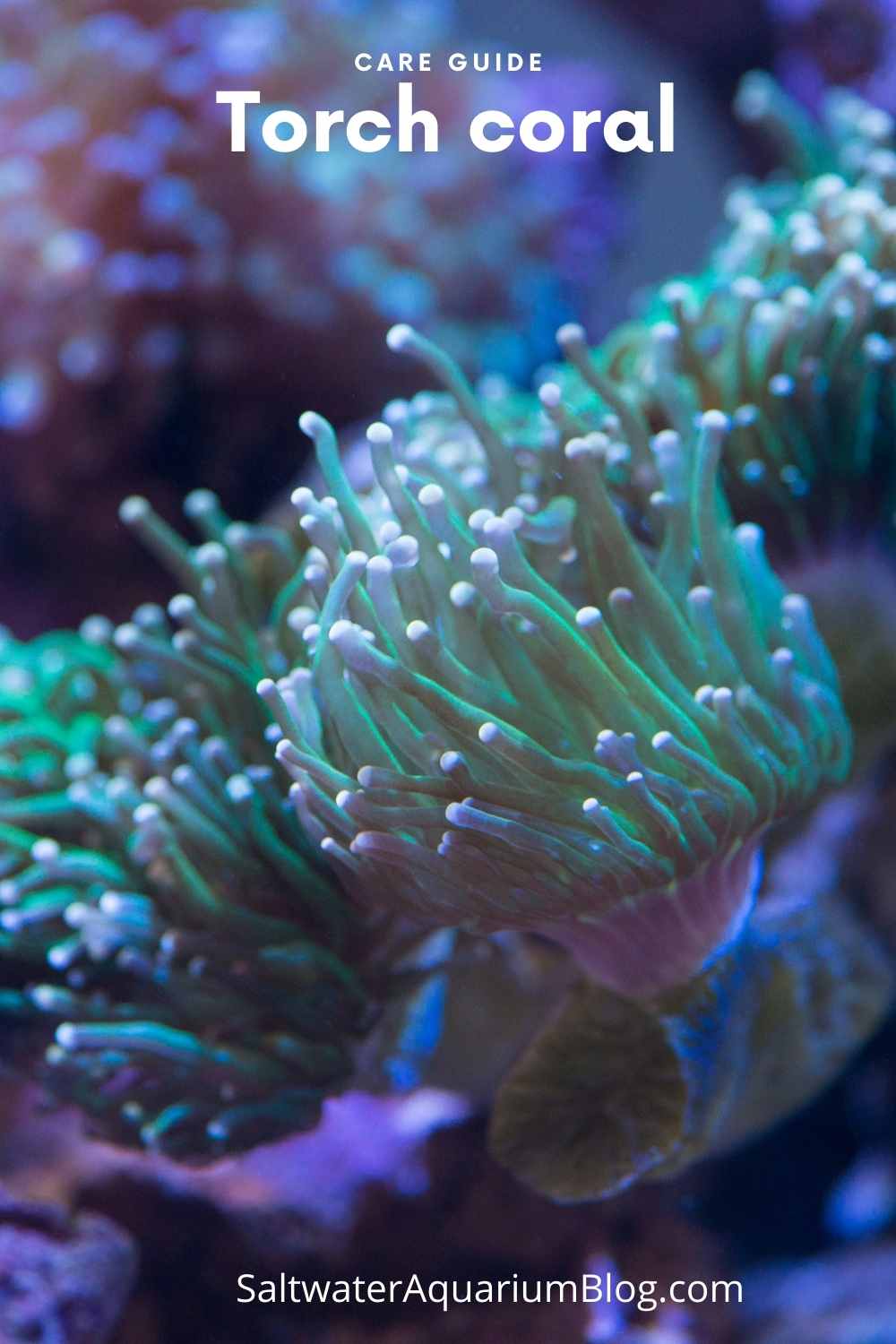
Are you on Pinterest? Pin this to your board
This article was written by Albert B. Ulrich III–author of The Reef Aquarium Series of books: The New Saltwater Aquarium Guide, How to Frag Corals, 107 Tips for the Marine Reef Aquarium, and The Reef Journal.
[ad_2]
Source link

